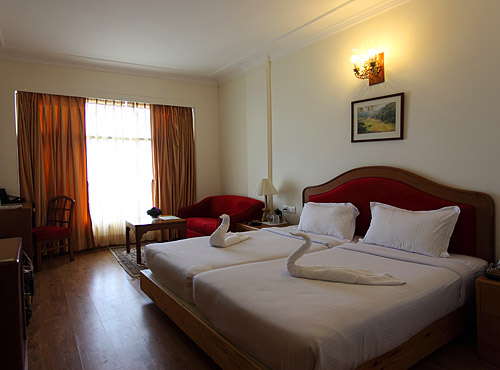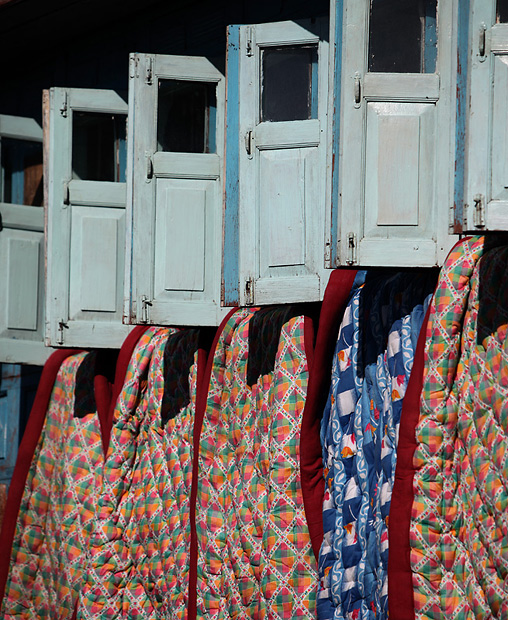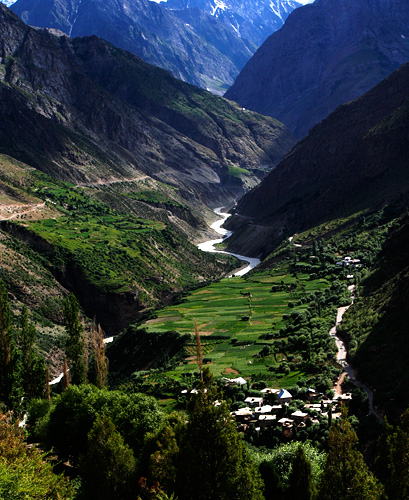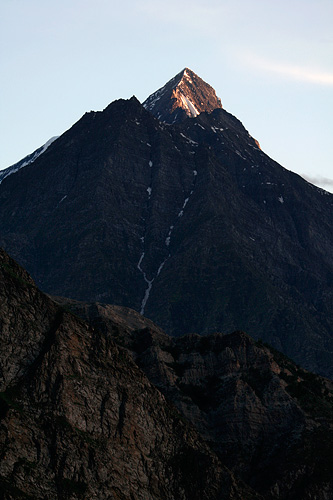Shimla and Mashobra
I woke up bleary eyed, took out my toothbrush and casually pulled the curtains before heading to the bathroom. One look outside the window, I threw away the toothbrush and rushed down with my tripod and camera. The view of the orange skies and sun surfacing over jagged ridges was something I did not want to miss. Toothbrush could wait.
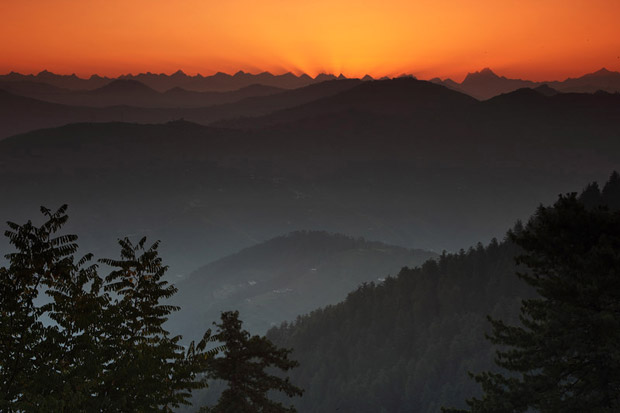
Sunrise at Mashobra
I can go on to explain how the sky changed colour, how the ridges were stacked up below a brilliant sky and how I felt exalted after witnessing the drama. But words can make the whole affair dull and stilted.
Birds arrived soon after sunrise. A small bunch of black throated tits took fancy to a tree next to me, where they hopped on from branch to branch, probably looking for breakfast. A pine tree hosted a brown thrush-like bird, which glittered on a shaft of sun rays that penetrated through the leaves. I don’t know the names of much of Himalayas bird species, but sometimes names do not matter. It can be like watching a little girl run around and giggle in a nice quiet place; it doesn’t matter what she is called.
Waking up early in the morning has its good effects on you. But on this particular day, goodness did not last beyond breakfast. I was spending my days at Mashorba, a village near Shimla on invitation from Club Mahindra. Holidaying with a small bunch of travel writing fraternity, I had four good days spent amidst the mountains. The holiday had a few dull moments too, and it was one such day of dullness. A filling breakfast later, we spent a good hour waiting to be rescued from a traffic jam in Shimla and drove further on a seemingly never ending highway past hundreds of vehicles, ugly towns, a terrible accident before finally reaching Kasauli in the middle of the day.
Kasauli was recommended as a great place to go by one of our fellow travellers who himself decided to go elsewhere that day. “It’s a nice place, go to Kasauli,” he had told us, and we had immediately finalized our plans for the day. One of us asked our driver as we approached the town, “what is there to see in Kasauli,” for which he had casually replied, “market hai, mandir hai, sunset point hai” – ‘there is a market, there is a temple, there is a sunset point’. We had arrived there on mid-day and were planning to be back in Shimla by the hour of sunset. I understood why our man who recommended Kasauli to us decided to go somewhere else himself. But not to undermine the beauty of the place, it is a quiet and nice cantonment area – a great location provided you are an army major and have a cozy house to live there. Not otherwise.
After a quick walk around Kasauli, we were back to what we were doing before – driving through a highway past hundreds of vehicles, ugly towns and waiting to be rescued from a traffic jam in Shimla.
They say you have to go through some pain to be able to appreciate all good things in life. Indeed, remaining days in Shimla were spent appreciating those good things. In the small town of Chail where we went next day, I appreciated the beauty of deodar trees growing tall on the slopes carpeted with lush grass. I watched grey wagtails hop skip and jump on the road doing what they are best at – wagging their tails! I eyed on a Eurasian Jay in the thick woods and felt happy seeing them for the first time. I argued with people for calling a magpie something else, and cursed myself later for not bothering to accept a bet and missing out on some fortune. I happily shot pictures of ridge lines, knowing fully well that some of my friends will accuse me of coming back with stereotype images. It turned out later that my friends were very predictable!
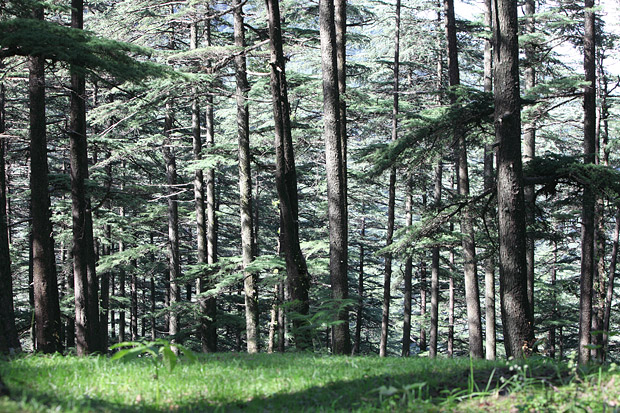
Deodars forest on the way to Chail
Chail was a place I looked forward to seeing again. I had fallen in love with its thick cedar forests when I was there three years ago (Read: my previous visit to Chail). When I first saw the market in the center of the town, it had given me an impression that there could be a large sprawl of shops out there. But I was taken by surprise to see the buildings vanish on a bend making way to another expanse of cedars. With a blanket ban on construction activity here, the quiet woods, the tall trees, the idle village had remained unchanged and unaffected by the rush of tourists since my last visit. Except for a minor addition. Someone had added an addition zero to the entry fee to Chail Palace, which then used to cost Rs.10/- Now, a fading sign at the gates said 100/- and helpfully mentioned that it can be reimbursed against accommodation charges. I reminded myself not to forget the reimbursements the next time I come here to stay at the Maharaja Suite. Just for the record, it costs about 15,000.
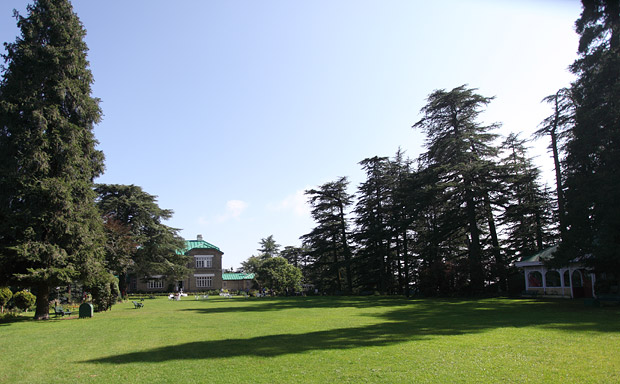
The palace built by Maharaja of Patiala in Chail
I was still thinking about Chail when we went camping in the middle of cedar trees next evening. It was a tad luxurious for a camp, but was a cozy place for a good conversation around the warmth of the fire. Much food was consumed as the well read and well travelled folks prattled on William Dalrymple, Amitav Ghosh, Gerald Durrell, Che Guevara, Twain and Dickens and more. A smattering of that night’s conversation is documented here. I am told that the chatter progressed into a raucous cacophony till small hours of the morning, but I slept peacefully in my tent dreaming of cedar trees.
Next morning, strengthened by a breakfast of best ever Aloo Parathas I have ever had, we walked through a stretch of one such cedar forest to get back to the resort, loosing our way briefly before getting back on track and resisting insistences of one of us to try and chalk out a straight line path to the resort through the steep slopes. The rewards of the walk came in the form of a few encounters, like the one with a congenial elderly shepherd who conversed fondly with his dog, a few birds and a waterfall. Not to forget is the ‘feel good’ of the deodar forests.
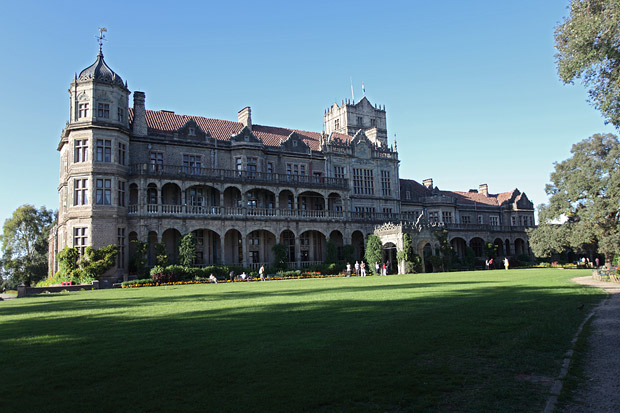
Viceregal Lodge, Shimla
Later in the day, we did what the tourists must do in Shimla – make a visit to the Viceregal Lodge and a walk up and down the mall (Read more: Walks in Shimla Mall Road, spending a day at Shimla Mall). While mall was a familiar territory, Viceregal lodge impressed and surprised me by its efficient construction and tastefully built exteriors. Raj Verma, the guide at the lodge showed us the furnishing and woodwork, electrical wiring and switches and decoratives that have survived the 121 years since the lodge was built. The foresighted architects of the lodge had implemented rainwater harvesting and had made provisions for electric wiring in the walls at a time when Shimla had no electricity at all. No wonder that the lodge is still used with very little modifications.
At the end of the touristy venture to Shimla, we were enslaved in the evening by the preparations of sous chef Vikas. I wonder what addictives he puts into his appetizers. I came to the restaurant every night with a resolve to eat very little, but never manage to stop before I could take no more. And when it comes to saying ‘thank you,’ I must not forget the tireless resort manager Mohnish.
The visit to Shimla and Mashobra ended just the way it started. We journeyed through the highway that seemed never-ending on a day that is easily the most boring one in the entire trip, even surpassing that uninspiring day when we waded past Shimla’s traffic towards Kasauli.
About Mashobra and Shimla
Mashobra is a small village, about 10km from Shimla on the Hindusthan-Tibet highway. The place has beautiful deodar forests and some great views of the mountain ranges. Read more about Shimla and surrounding places in an earlier post.
About the resort
Club Mahindra Whispering Pines Gables in Mashobra is a resort owned by Mahindra Holidays. Read more about the resort on Club Mahindra website.
